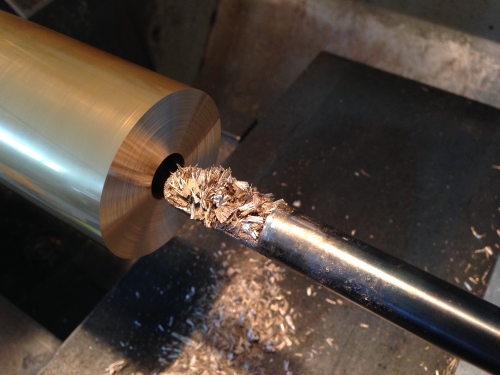Making a Cannon Barrel is boring
by John
The bore in my 1779 naval cannon is 14mm diameter, 270mm deep.
I made a D bit from silver steel, as per the Jerry Howell plans. I tried it without heat treating, but it blunted after boring a couple of centimeters so I heated it red hot and quenched it in water, then annealed it and resharpened it. There were no further issues with edge holding.
I then tried it without, then with, a preliminary drilled hole in some scrap. I have decided that it is better to give it a starting hole of the correct diameter.

This is the setup. The 50mm brass rod is held in a 3 jaw chuck, and the tailstock end held in a centre while the chuck jaws are tightened. The bore is then started with a drill which is accurately sharpened. Then the D bit is fitted, and the deep boring job starts. I used an accurate 3 jaw chuck in the tailstock to hold the D bit. The headstock does not accept 50mm stock, but the 3 jaw chuck does, albeit with some stick out. Once the D bit enters the workpiece, it acts to stabilise the workpiece. The whole process was easier than I had anticipated.

Each peck of the bit advances 2-2.5mm. The D bit is withdrawn and the chips are cleared. Initially I used a small brush, but as the hole deepened, the brush was replaced with a compressed air blast, delivered through a small bore copper pipe.
The 270mm bore took 2 hours to complete. It was not a boring job. I was anxious not to muck up the hefty lump of brass.
Next to drill the trunion holes in the barrel stock. That will be straight through all layers of the barrel. (retrospective note added later… The trunnion holes were stopped short of the bore, and I was just very careful to keep the holes at 180 degrees and in line)
Then to turn the exterior of the barrel. There will be a video if that is successful.
Then to silver solder the trunnions to the barrel in one piece. Then to use the D bit to rebore the barrel, removing the trunnion rod which is obstructing the bore. Some readers will not agree with this method, and it is not according to the Jerry Howell plans, but it does ensure that the trunnions are exactly in line with each other. Silver solder, if properly used, is said to be as strong as the parent metal, so I believe that I will not be compromising the integrity of the barrel. The main disadvantage is that the finished exterior of the barrel will need to be held in the 3 jaw chuck during that final D bit reboring. I have not quite worked out how to do that, while avoiding marking the finished brass surface.

Hi John
We have not spoken for a while, trust you are fine
I am quietly following along your built processes and they are just beautiful. I hope you dont mind, the guys on HMEM was enquiring about model canons and I pasted your blog’s link to them
Take care
Albert
LikeLike
No problems at all Albert. Very happy for the publicity. And thank you. All the best. John
LikeLike
John just finished my Red Wing Project if you want to take a look at http://www.homemodelenginemachinist.com/showthread.php?t=25686
The entire built is also there. I am now busy rebuilding a Stuart Beam Engine.
The Bolton #7 has still not been shipped and I am at lock a heads with the supplier. Its very sad actually
Albert
LikeLike
The Redwing looks superb, and runs very nicely! Does it power up when you put a bit of friction on the flywheel?
I particularly like the mix of painted castings, polished brass, polished iron and beautifully finished wood. Very nice woodwork too! Congratulations Albert. John.
ps. sorry to hear about your issues with EJ Winter. Time to ask for a refund?
LikeLike
Hi John, oh yes it does exactly that, in my built is a link of the unpainted version running or you can look me up on youtube where I’ve put drag on the flywheel and also disabled the governor for few seconds. Runs like a dream man.
Yeah I did ask for a refund but he gave me a rather kick in you know what yesterday. I am reporting him to NSW Fair Trading. I was really looking forward to build the engine, but thats that.
LikeLike
If I can help, let me know. It is embarrassing, as a fellow Australian.
LikeLike
Hi John, I responded yesterday but I notice the post is missing, here we go again, yes indeed with friction it picks up power to sustain the governor setting. There is a video of the unpainted version also on youtube where I added friction and even disabled the governor for a few seconds.
I did ask for a refund from him but he did not really respond to that and said I can even go to the small claims court whilst he is at a funeral this time and said he will look at it again when he is back in office. Its now 7 months.
LikeLike